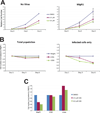Inhibition of gamma-secretase activity inhibits tumor progression in a mouse model of pancreatic ductal adenocarcinoma
- PMID: 19208345
- PMCID: PMC3675892
- DOI: 10.1053/j.gastro.2009.01.008
Inhibition of gamma-secretase activity inhibits tumor progression in a mouse model of pancreatic ductal adenocarcinoma
Abstract
Background & aims: The Notch signaling pathway is required for the expansion of undifferentiated pancreatic progenitor cells during embryonic development and has been implicated in the progression of pancreatic ductal adenocarcinoma (PDAC). The interaction of Notch ligands with their receptors promotes a gamma-secretase-dependent cleavage of the Notch receptor and release of the Notch intracellular domain, which translocates to the nucleus and activates transcription. We investigated the role of this pathway in PDAC progression.
Methods: We tested the effects of a gamma-secretase inhibitor (GSI) that blocks Notch signaling in PDAC cell lines and a genetically engineered mouse model of PDAC (Kras p53 L/+ mice).
Results: Notch signaling was activated in PDAC precursors and advanced tumors. The GSI inhibited the growth of premalignant pancreatic duct-derived cells in a Notch-dependent manner. Additionally, in a panel of over 400 human solid tumor-derived cell lines, PDAC cells, as a group, were more sensitive to the GSI than any other tumor type. Finally, the GSI completely inhibited tumor development in the genetically engineered model of invasive PDAC (P < .005, chi2 test; compared with mice exposed to vehicle).
Conclusions: These results suggest that Notch signaling is required for PDAC progression. Pharmacologic targeting of this pathway offers therapeutic potential in this treatment-refractory malignancy.
Figures




Comment in
-
Notch signaling: where pancreatic cancer and differentiation meet?Gastroenterology. 2009 May;136(5):1499-502. doi: 10.1053/j.gastro.2009.03.022. Epub 2009 Mar 25. Gastroenterology. 2009. PMID: 19327730 No abstract available.
References
-
- Jemal A, Siegel R, Ward E, Hao Y, Xu J, Murray T, Thun MJ. Cancer statistics, 2008. CA Cancer J Clin. 2008;58:71–96. - PubMed
-
- Burris HA, 3rd, Moore MJ, Andersen J, Green MR, Rothenberg ML, Modiano MR, Cripps MC, Portenoy RK, Storniolo AM, Tarassoff P, Nelson R, Dorr FA, Stephens CD, Von Hoff DD. Improvements in survival and clinical benefit with gemcitabine as first-line therapy for patients with advanced pancreas cancer: a randomized trial. J Clin Oncol. 1997;15:2403–2413. - PubMed
-
- Hansel DE, Kern SE, Hruban RH. Molecular pathogenesis of pancreatic cancer. Annu Rev Genomics Hum Genet. 2003;4:237–256. - PubMed
-
- Konieczny SF, Leach SD. Metaplastic metamorphoses in the mammalian pancreas. Gastroenterology. 2007;133:2056–2059. - PubMed
-
- Murtaugh LC, Leach SD. A case of mistaken identity? Nonductal origins of pancreatic "ductal" cancers. Cancer Cell. 2007;11:211–213. - PubMed
Publication types
MeSH terms
Substances
Grants and funding
LinkOut - more resources
Full Text Sources
Medical
Molecular Biology Databases
Research Materials
Miscellaneous

